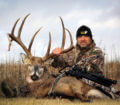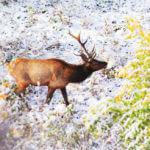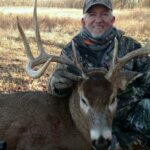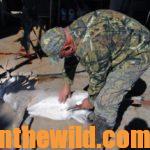One time when I was sitting in my tree stand in the middle of a rainstorm, I had discounted completely the major reason for hunting from a tree stand – placing it in the most-productive section of the woods to try and bag a deer. I also had not paid attention to the weather or the wind direction.
What constitutes a productive place to put a tree stand to take an extraordinary buck? Here are some ideas successful tree stand hunters use, and much of what they know they’ve learned from the trail cameras.
* Locate an area where the deer are feeding;
* Find a hot scraping region where the deer want to breed;
* Discover a trail that the deer are using heavily;
* Locate a creek crossing;
* Find a funnel area;
* Set-up an escape route; and
* Pick the spot that provides the very best opportunity in the region for taking a deer.
 Let’s examine each of these sites to learn why they are effective regions in which to place tree stands.
Let’s examine each of these sites to learn why they are effective regions in which to place tree stands.
* Feeding Areas – Deer feed on many different types of grasses, bushes and nuts – more than 300 varieties. Although the whitetail is a browser, usually he will prefer one food source. Find a particular food source in short supply, and oftentimes that food source will concentrate the deer. Then you can set-up your tree stand close to the food source and have a better-than-average chance of bagging a deer. Remember to keep your stand a sufficient distance from the food source, so the deer doesn’t see you when he comes in to feed.
* Hot Scrapes – A hot scrape can be defined as a scrape that has a well-used deer trail coming to it through thick cover, a strong urine smell in the pawed-up ground at it and a limb hanging over the pawed-up ground that has been crunched by the deer. During the rut and even before and after the rut, deer make many scrapes. But these factors characterize a very-active scrape. Generally the best site in which to set your stand is 30-50 yards downwind of a scrape. An older, smarter buck may come into a scraping area 20-30 yards downwind of the scrape to test the air for a doe close to the scrape. Not smelling the scent of the doe, he then may go onto his scrape and work it. If you put up your tree stand 30-50 yards below the scrape on the downwind side, your chances of taking the whitetail are greater.
* Trails – The whitetail is a creature of habit that moves from one place to another as methodically as most of us go to and from the grocery store on certain days at specific times. To set-up your tree stand close to the best trail, look for a path in the woods that has tracks going both ways. Then you will know the deer are using this trail when they travel in either direction. More deer movement will be along this trail than a trail that has tracks only leading in one direction.
* Creek Crossings – Deer usually will cross a creek or a branch at the same points most of the time. A creek crossing where the water is more-shallow than surrounding water or where the distance between the two banks is shorter is a productive spot to set-up your tree stand.
* Funnel Areas – Deer will funnel between two types of habitat to move from one woodlot to another. For instance, if a large expanse of woods is divided by a narrow point where a field corners and a creek offers a barrier on the other side of the funnel, the woods between the corner of the field and the creek is a productive spot for a tree stand. Most deer in both sections of the woods will prefer to walk through the funnel in that narrow neck of woods between the creek and the field – rather than swimming the creek or walking in the open field. Although funnel areas may be the best opportunity for taking a deer from a tree stand, don’t be concerned if you don’t find trails in these funnel regions. Often deer will meander through funnels rather than utilizing well-defined trails.
 * Escape Routes – Bucks have certain trails or routes they take to escape danger. When hunting pressure is heavy in a part of the woods, deer usually will flee down escape trails to miss the hunters. Oftentimes these trails will be coming out of thick cover or will have tracks running in one direction away from the area where most of the hunters enter the woods. By getting into your tree stand close to an escape route well before daylight, you may have the opportunity to bag your buck as he attempts to run from the other hunters entering the woods.
* Escape Routes – Bucks have certain trails or routes they take to escape danger. When hunting pressure is heavy in a part of the woods, deer usually will flee down escape trails to miss the hunters. Oftentimes these trails will be coming out of thick cover or will have tracks running in one direction away from the area where most of the hunters enter the woods. By getting into your tree stand close to an escape route well before daylight, you may have the opportunity to bag your buck as he attempts to run from the other hunters entering the woods.
* Best Spots – A deer hunter who is familiar with how to scout for deer often will find 10-20 good tree stand sites in 1/2-acre of woods. To be an effective tree-stand hunter, you must eliminate 19 of these stand sites and choose the one you assume provides the best opportunity to take a deer on the day you plan to hunt.
* Wind Effects – Another ingredient helpful for any stand site is being on the best spot to hunt into the wind. Because the most-effective tree stand hunters for extraordinary bucks are the ones who hunt from tree stands in prime areas with a favorable wind, many successful deer hunters use a multiple stand-hunt plan. This concept requires you to have more than one tree stand in the woods on the day you plan to hunt. The most-productive hunters I know may have from 5-20 stands or stand sites from where they can hunt. Many of them have their stands in place prior to the day they hunt, and each of these stands is in a prime deer area. These successful outdoorsmen know what type of wind direction they must have to approach these stands with a favorable wind. Depending on the wind direction, they eliminate the stands they can’t hunt from that day because their scents will be carried into the hunting areas.
 If you’re hunting from the very-best stand you can choose, have found the most-productive place in the woods to hunt and are in your tree stand at the extraordinary buck’s prime moving times, but then you fall asleep, daydream or become distracted, all your time and energy are wasted. Because you have scouted, studied trail-camera photos and identified the best region to hunt, be confident you can see the deer from this stand. When you are in your tree stand, look for deer, let your eyes constantly search your surroundings, work out your game plans as to where and when you will take the deer if he appears, and study every log, tree and bush. Also look for the tips of a buck’s antlers, watch for the white swish of a tail, and notice parallel lines that are 3-4 feet off the ground, which indicates the buck’s back. Concentrate on hunting.
If you’re hunting from the very-best stand you can choose, have found the most-productive place in the woods to hunt and are in your tree stand at the extraordinary buck’s prime moving times, but then you fall asleep, daydream or become distracted, all your time and energy are wasted. Because you have scouted, studied trail-camera photos and identified the best region to hunt, be confident you can see the deer from this stand. When you are in your tree stand, look for deer, let your eyes constantly search your surroundings, work out your game plans as to where and when you will take the deer if he appears, and study every log, tree and bush. Also look for the tips of a buck’s antlers, watch for the white swish of a tail, and notice parallel lines that are 3-4 feet off the ground, which indicates the buck’s back. Concentrate on hunting.
When you no longer can focus on hunting, come out of the tree, and either move to a new tree-stand site or go home, and plan to hunt another day. Some of the most-effective hunters I know only may stay in their tree stands for 2 hours in the morning and 2 hours in the afternoon. If you are in your tree stand sleeping, you are not hunting. Also you risk falling out of your stand and dropping your bow or your gun.
Tree stand hunting gives you a better view of the woods, a way to get your scent up off the ground, the opportunity to sit quietly from an elevated shooting platform for a long time and is, in my opinion, one of the very-best ways to take an extraordinary buck. However, knowing where to put your tree stand, when to hunt from it, and what to do when you are in the stand may be the difference in your success or failure as a tree stand hunter to take an extraordinary buck.
To learn more about hunting deer with John E. Phillips’ Amazon Kindle eBooks, print books and Audible books (the latest Audible is “How to Hunt Deer Like a Pro”) and Nook books, click here at https://johninthewild.com/books/#deer. You can type in the name of the book and download it to your Kindle, and/or download a Kindle app for your iPad, SmartPhone or computer. For a free download on how to make jerky from venison to provide a protein-rich snack, choose “How to Prepare Venison Jerky: The Ultimate Snack Food” at johninthewild.com/free-books.
















